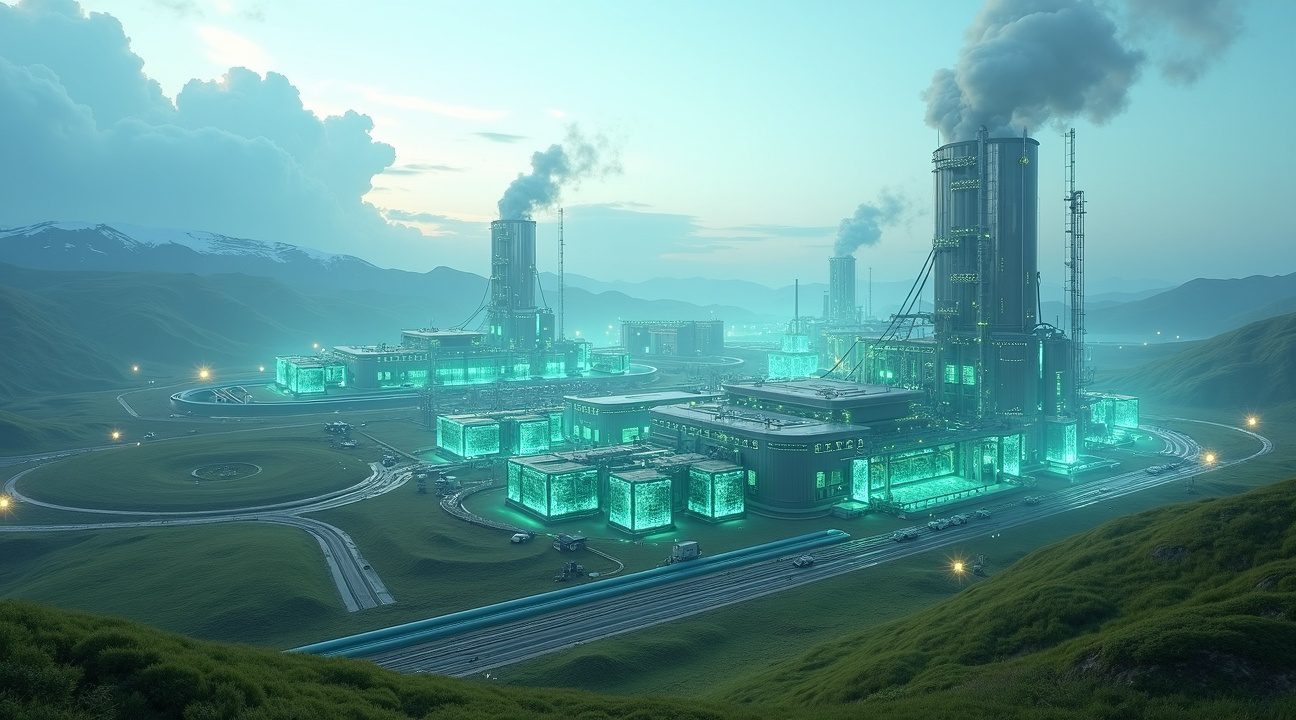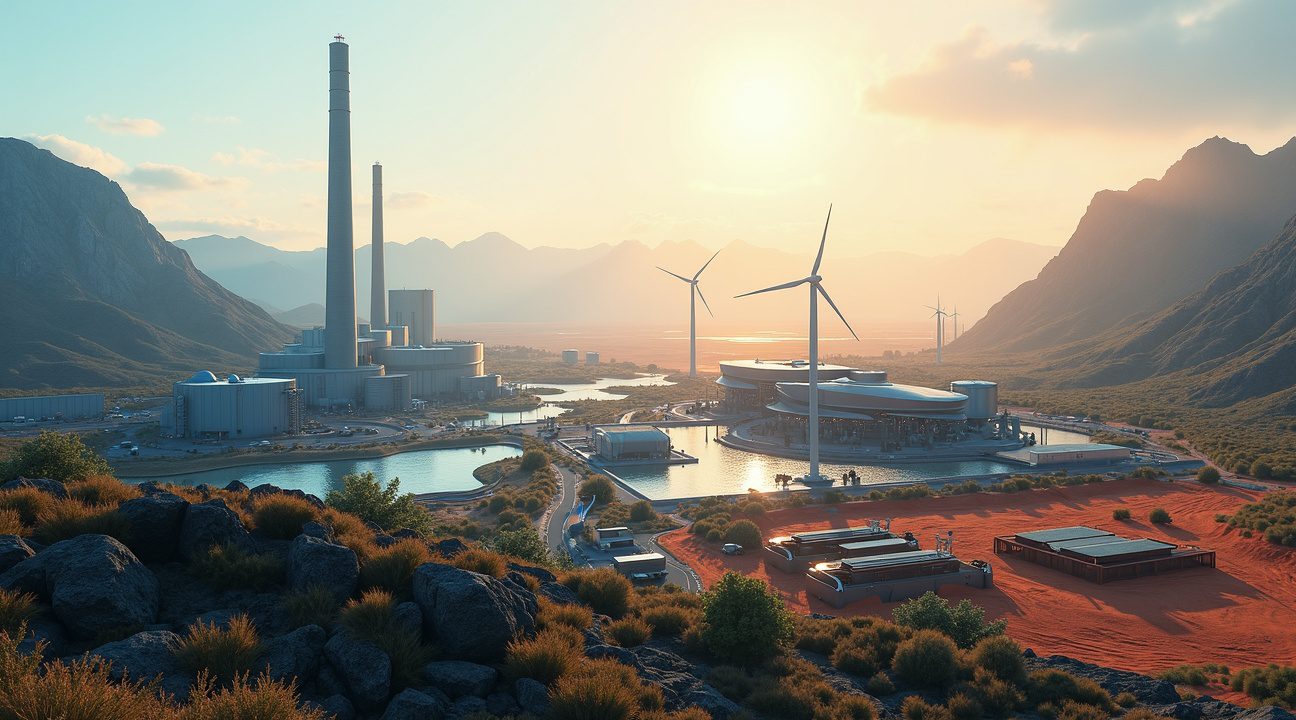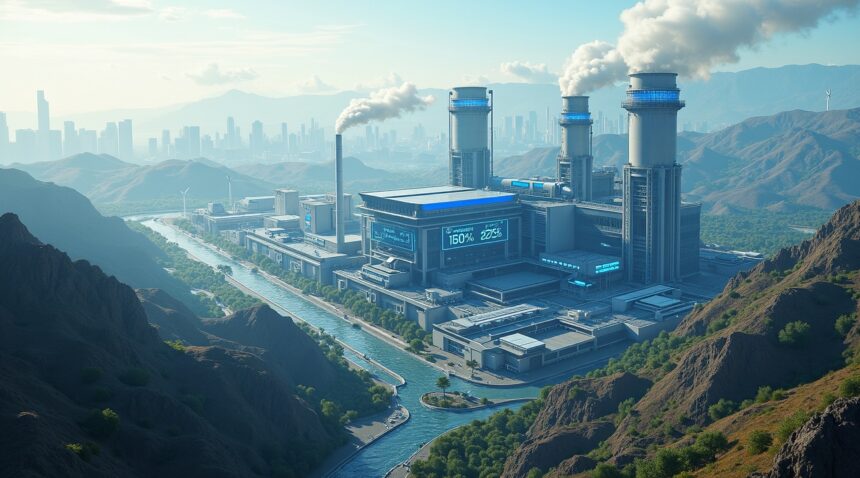America leads the world in carbon capture technology, operating 19 commercial facilities that remove over 22 million metric tons of CO2 each year. The nation develops 270 additional projects worth $77.5 billion. These advanced machines achieve remarkable 99% capture efficiency rates. They transform a $2-6 billion market into a projected $20.6 billion industry by 2035. These systems literally help the planet breathe by extracting carbon directly from the atmosphere.
Key Takeaways
- America operates nearly half of the world’s carbon capture capacity, with 19 commercial facilities removing 22 million tons of CO2 annually. This positions the country as the undisputed global leader in atmospheric carbon management.
- Next-generation capture technologies achieve breakthrough 99% efficiency rates using advanced systems such as Metal-Organic Frameworks and Temperature Swing Adsorption, marking a significant leap from earlier solutions.
- The carbon capture market is experiencing explosive growth, expanding from $2–6 billion currently to a projected $20.6 billion by 2035. This surge is fueled by growing investor confidence and a tripling of investment to $6.4 billion in 2024 alone.
- Game-changing facilities like Texas’s STRATOS plant and Iceland’s Mammoth facility demonstrate that industrial-scale direct air capture is not only possible but viable, with some operations processing up to 36,000 tonnes of CO2 each year.
- Significant challenges remain on the road to net-zero emissions. While current global capacity is about 50 million tonnes annually, it falls drastically short of the 1,300 million tonnes needed. Policy uncertainty further threatens America’s lead in carbon capture innovation.
For more information on how carbon capture technologies are evolving and reshaping environmental strategy, visit the International Energy Agency’s report on CCUS.
How America Leads the World in Capturing 22 Million Tons of CO2 Annually
I’ve watched America emerge as the undisputed global champion in carbon management, with the country now capturing over 22 million metric tons of CO2 annually through 19 commercial-scale facilities. This impressive achievement represents roughly half of the world’s total carbon capture capacity, demonstrating American innovation in climate technology solutions.
The scale of American ambition in this field becomes even clearer when examining the pipeline of future projects. More than 270 announced carbon capture initiatives are currently in development across the United States, backed by capital investments totaling $77.5 billion. These projects collectively promise a projected capture capacity approaching 200 million metric tons per year, representing a nearly ten-fold increase from current levels.
Economic Impact and Future Projections
The Department of Energy’s economic projections paint a compelling picture of carbon capture’s potential contribution to American prosperity. Deployment levels between 500 and 1,200 million metric tons per annum could inject $75–$110 billion into the U.S. economy by 2030. Looking further ahead, these investments could generate up to $1.5 trillion in economic value by 2050, creating jobs and establishing America as the dominant force in global carbon management.
Targeting Hard-to-Decarbonize Industries
Carbon Capture and Storage (CCS) technology addresses one of climate action’s most persistent challenges: industrial decarbonization. Heavy industries present unique obstacles for emissions reduction, making traditional renewable energy solutions insufficient on their own. CCS provides practical pathways for these sectors to reduce their carbon footprint while maintaining operational efficiency:
- Cement manufacturing, which accounts for approximately 8% of global CO2 emissions
- Steel production, responsible for roughly 7% of worldwide carbon emissions
- Chemical processing facilities that rely on carbon-intensive production methods
- Petrochemical plants requiring specialized decarbonization approaches
These industrial applications showcase why America’s leadership in carbon capture extends beyond environmental benefits. The technology enables domestic manufacturing to remain competitive while meeting increasingly stringent environmental standards. Companies can maintain production levels while dramatically reducing their carbon intensity, creating a win-win scenario for both economic and environmental objectives.
The success of American carbon management initiatives has also sparked interest in related innovative projects, from NASA’s ambitious space projects to breakthrough developments in automation technology. This interconnected approach to technological advancement positions the United States at the forefront of multiple emerging industries that will define the next century’s economic landscape.
Revolutionary Machines Achieving 99% Carbon Capture Efficiency
I’ve watched the carbon capture industry transform dramatically over the past few years, with American companies leading breakthroughs that are literally helping our planet breathe easier. Advanced Carbon Capture and Storage technologies now achieve over 90% CO2 capture efficiency through innovative solid sorbents like Metal-Organic Frameworks, representing a quantum leap from earlier systems.
Next-Generation Capture Technologies
Temperature Swing Adsorption has emerged as a game-changing approach, working alongside MOF-based systems to deliver unprecedented performance. Next-generation amine-based systems are pushing CO2 capture rates up to an astounding 99%, while simultaneously lowering associated costs that previously made large-scale implementation challenging.
Companies like Nuada are pioneering MOF-based systems that offer superior efficiency compared to traditional methods. Dotz Nano has developed fascinating plastic-waste-derived sorbents, turning environmental problems into solutions. These artificial intelligence enhanced systems optimize capture processes in real-time, maximizing efficiency while minimizing energy consumption.
Large-Scale Direct Air Capture Facilities
Direct Air Capture technologies have moved from concept to reality with impressive installations across the globe. 1PointFive’s STRATOS plant in Texas stands as the world’s largest DAC unit, demonstrating American leadership in this critical technology. Climeworks’ Mammoth facility in Iceland operates with a 36,000 tonnes per year capacity, proving that industrial-scale carbon removal is achievable.
Technological improvements have dramatically reduced DAC energy use and costs by up to 50%, with industry targets aiming for $250–$350 per tonne by 2030. Northern Lights provides essential infrastructure development in Norway, creating the backbone for carbon transport and storage networks. These facilities represent more than experimental projects—they’re operational proof that massive technological projects can deliver real environmental impact.
The sector is experiencing rapid growth fueled by these breakthroughs, with CCS expected to quadruple in scale by 2030. This expansion reflects both improved technology performance and decreasing costs that make carbon capture economically viable. As these revolutionary machines continue advancing, they’re creating new possibilities for addressing climate change at the scale our planet desperately needs.

A $20.6 Billion Market Explosion Transforming Climate Technology
I’ve witnessed an extraordinary transformation in the carbon capture and storage industry that’s reshaping how America approaches climate solutions. The global CCS market currently operates between $2–6 billion and is expanding at an impressive yearly rate of 7–14%. This growth trajectory points to something remarkable: projections show the market will reach $20.6 billion by 2035, driven by a compound annual growth rate of 14.2%.
Investment momentum has reached unprecedented levels since 2022. CCS investments have tripled in just two years, climbing to $6.4 billion in 2024. This surge reflects growing confidence in carbon capture technologies and their potential to address climate challenges at scale.
Project Development Reaches Critical Mass
The project landscape tells an equally compelling story. Currently, over 628 CCS projects operate worldwide—representing a 60% increase from 2023 alone. The United States claims a major share of these developments, positioning itself as a leader in carbon capture infrastructure.
According to the International Energy Agency, the scale of expansion needed is staggering. Storage capacity must increase 90-fold to meet global climate targets. This means capturing 4.0 gigatons of CO2 by 2040 and scaling up to 10.0 gigatons by 2050. These numbers highlight both the challenge and the enormous market opportunity ahead.
Policy Framework Drives Market Acceleration
Federal legislation has become the catalyst for this market explosion. The Infrastructure Act and the 45Q tax credit have created powerful financial incentives that make CCS projects economically viable. These policy tools work alongside state-level initiatives to stimulate project announcements and unlock substantial funding streams.
The 45Q tax credit deserves particular attention because it directly rewards carbon capture activities with tax incentives. This mechanism has proven especially effective at encouraging private sector investment in CCS technologies. State governments have responded with complementary programs that address local environmental goals while supporting federal climate objectives.
Market analysts recognize that policy incentives create the foundation for sustained growth. Without these regulatory frameworks, many CCS projects would struggle to achieve financial viability. The combination of federal support and state-level enthusiasm has created an investment climate that attracts both domestic and international capital.
Recent developments in artificial intelligence applications are also contributing to CCS efficiency improvements. AI systems help optimize capture processes and predict storage performance, making projects more attractive to investors.
The economic implications extend beyond direct CCS investments. Supporting industries, from engineering services to specialized equipment manufacturing, are experiencing rapid growth. This ripple effect creates jobs across multiple sectors while building the infrastructure needed for large-scale carbon management.
Infrastructure development requirements are substantial but manageable given current investment trends. Pipeline networks, storage facilities, and monitoring systems all require significant capital commitments. However, the projected market growth suggests these investments will generate strong returns as demand for carbon management services increases.
International competition is intensifying as countries recognize the strategic importance of CCS technology leadership. America’s early investments in policy frameworks and project development provide competitive advantages that could translate into export opportunities for CCS technologies and services.
The path from today’s $2–6 billion market to the projected $20.6 billion market by 2035 depends on continued policy support and technological advancement. Current trends suggest this growth is not only possible but likely, given the urgent need for effective climate solutions and the proven ability of well-designed incentives to drive private sector innovation.
Market fundamentals remain strong because carbon capture addresses a critical need that few alternatives can match at scale. As global awareness of climate risks increases, demand for proven carbon management solutions will continue expanding, supporting sustained market growth well beyond current projections.

Game-Changing Projects from Texas to Iceland Leading Global Innovation
I’ve witnessed the rapid emergence of pioneering carbon capture projects that stretch across continents, each pushing the boundaries of what’s possible in atmospheric carbon removal. These initiatives represent more than experimental technology—they’re operational facilities making tangible impacts on global carbon levels.
Breakthrough Commercial Operations Setting New Standards
The Northern Lights project in Norway has established itself as the first commercial cross-border CO2 transport and storage venture, demonstrating how international collaboration can accelerate carbon capture deployment. With Phase 1 already capable of storing 1.5 million tonnes per annum, this ambitious project has secured €131 million in EU funding and plans to expand capacity to 5 Mtpa. This scaling approach shows how initial success can pave the way for exponential growth.
In Iceland, the Climeworks Mammoth facility currently holds the distinction of being the world’s largest direct air capture (DAC) plant, processing 36,000 tonnes of CO2 annually. The facility leverages Iceland’s abundant geothermal energy and unique geological conditions to optimize both power supply and permanent storage solutions.
Meanwhile, Texas hosts the 1PointFive STRATOS facility, which stands as the world’s largest DAC operation by overall capacity. This facility demonstrates how America is positioning itself at the forefront of artificial intelligence integration in carbon capture systems, using advanced algorithms to optimize capture efficiency and energy consumption.
Australia contributes significantly to this global effort through the Moomba CCS project, which offers an impressive capacity of 1.7 Mtpa. This facility showcases how established oil and gas infrastructure can be repurposed for carbon storage, creating economic value while addressing climate concerns.
Revolutionary Technology Companies Reshaping Carbon Capture
Beyond these large-scale facilities, innovative companies are developing next-generation capture technologies that promise even greater efficiency and cost-effectiveness.
- Nuada has pioneered MOF-based (Metal-Organic Framework) sorbents that dramatically improve capture rates while reducing energy requirements. These advanced materials can selectively capture CO2 from ambient air with unprecedented precision.
- Dotz Nano represents another breakthrough in the field, creating plastic-derived sorbents that support circular economy principles while capturing carbon. Their approach transforms waste plastics into high-performance carbon capture materials, addressing two environmental challenges simultaneously. This innovation demonstrates how modern solutions can tackle multiple sustainability issues through integrated approaches.
These technological advances complement the operational success of major facilities, creating a comprehensive ecosystem of carbon removal capabilities. The combination of proven large-scale operations and cutting-edge material science innovations positions these projects as catalysts for global carbon capture expansion.
I observe that these projects share several critical success factors:
- Strategic location selection
- Innovative financing models
- Integration with existing infrastructure
The diversity of approaches—from geothermal-powered DAC in Iceland to repurposed oil infrastructure in Australia—proves that effective carbon capture can adapt to various geographical and economic contexts.
The international scope of these initiatives highlights how carbon capture has evolved from theoretical concepts to commercial reality. Each project builds upon lessons learned from earlier deployments, creating a knowledge base that accelerates future development. This collaborative approach ensures that breakthrough technologies developed in one location can be rapidly adapted and deployed globally.
These facilities represent the foundation of what could become a massive global infrastructure for atmospheric carbon management. Their success demonstrates that the technology exists today to make meaningful reductions in atmospheric CO2 levels, provided sufficient investment and political support continue to drive expansion efforts.
https://www.youtube.com/watch?v=Z-YI0bExrMk

The Reality Check: Why Current Progress Still Falls Short
I find the gap between current capabilities and climate requirements staggering. Global carbon capture and storage capacity sits at roughly 50 million tonnes per year, yet achieving net-zero emissions demands approximately 1,300 million tonnes annually. This twenty-six-fold increase represents one of the most significant scaling challenges in modern industrial history.
Policy Uncertainty Threatens American Leadership
Policy instability poses perhaps the greatest threat to America’s position in CCS technology development. The Department of Energy’s decision to cancel $3.7 billion in CCS grants sent shockwaves through the industry, creating uncertainty that extends far beyond individual projects. Companies that invested millions in research and development suddenly faced an unclear regulatory landscape.
Congressional actions compound these concerns. U.S. House of Representatives activities and additional DOE decisions to curtail financing could severely hamper industrial innovation. Such policy reversals don’t just affect current projects – they signal to investors that long-term commitments in this sector carry significant political risks. This uncertainty directly threatens America’s technological leadership at a time when countries like Norway and the Netherlands are making substantial CCS investments.
Technical Hurdles Remain Formidable
Beyond policy challenges, fundamental technical barriers continue limiting widespread CCS deployment. Cost remains the primary obstacle, with current capture technologies requiring substantial capital investments that many industries struggle to justify. Scalability presents another critical challenge – technologies that work effectively at pilot scale often encounter unexpected complications during commercial deployment.
The technical complexities extend to infrastructure requirements that many regions simply can’t support. Finding suitable geological storage sites near industrial emission sources proves increasingly difficult as the technology expands. Transportation networks for captured carbon need massive infrastructure investments that current market conditions don’t adequately incentivize.
I observe that energy requirements for carbon capture processes can reduce overall plant efficiency by 15-30%, creating an energy penalty that works against emission reduction goals. These efficiency losses translate directly into higher operational costs and reduced competitiveness for facilities implementing CCS technology.
Storage safety concerns add another layer of complexity. Long-term geological storage requires extensive monitoring systems and poses potential environmental risks that regulatory frameworks are still developing to address. Public acceptance remains limited in many communities where storage sites might be located.
The convergence of these factors – inadequate funding, policy uncertainty, technical limitations, and public skepticism – creates a challenging environment for achieving the rapid CCS expansion that climate scientists emphasize as necessary. While artificial intelligence offers promising solutions for optimizing capture processes, these technological advances alone can’t overcome the fundamental economic and policy barriers that currently constrain the industry.
Policy Battles That Could Make or Break America’s Climate Tech Leadership
Federal policy initiatives stand at the crossroads of America’s climate technology future, with the Infrastructure Act and the 45Q tax credit serving as foundational pillars for carbon capture and storage (CCS) development. I’ve observed how these legislative frameworks create the economic incentives necessary for large-scale CCS deployment, yet their effectiveness remains vulnerable to the shifting political landscape that characterizes American governance.
The 45Q tax credit represents one of the most significant federal mechanisms for advancing carbon management technology. This policy provides up to $85 per metric ton of CO2 permanently stored underground, creating a direct financial incentive for companies to invest in carbon capture systems. However, political instability threatens to undermine these carefully constructed support systems, leaving project developers uncertain about long-term viability.
Recent developments have sent shockwaves through the carbon capture sector. The Department of Energy’s decision to cancel $3.7 billion in CCS grants has created widespread concern among industry stakeholders and researchers alike. This abrupt policy reversal demonstrates how federal funding fluctuations can disrupt multi-year project timelines and investor confidence, particularly when companies have already committed significant resources based on initial government commitments.
Congressional Challenges Threatening American Competitiveness
House of Representatives efforts to restrict CCS financing pose additional threats to America’s position in the global carbon management race. These legislative attempts could fundamentally undermine American energy independence by limiting domestic capacity to manage industrial emissions. I’ve seen how similar policy reversals in other technology sectors have allowed international competitors to gain strategic advantages while American companies struggle with regulatory uncertainty.
The implications extend beyond individual projects to encompass broader industrial competitiveness. Countries like Norway, Canada, and several European nations continue advancing their carbon management capabilities through consistent policy support, while American uncertainty creates opportunities for foreign technology leadership. This dynamic particularly affects advanced technological solutions that require sustained investment cycles to reach commercial viability.
Political risks manifest in multiple ways throughout the carbon capture ecosystem:
- Project developers face challenges securing long-term financing when tax credits and grants remain subject to congressional modification.
- Industrial partners hesitate to commit to capture installations without certainty about future regulatory frameworks.
- Research institutions adjust project scope based on anticipated funding availability rather than scientific merit.
State-level programs provide some stability amid federal uncertainty, with states like California, Texas, and Illinois developing their own carbon management initiatives. These localized efforts offer consistency for regional projects, but their limited scope cannot fully compensate for federal policy fluctuations. State programs typically focus on specific geographic areas or industry sectors, leaving gaps in national coverage that federal initiatives were designed to address.
The regulatory challenges extend beyond funding mechanisms to encompass permitting processes, environmental reviews, and interstate coordination requirements. Each layer of bureaucracy introduces additional uncertainty, particularly when federal agencies lack clear mandates or consistent leadership priorities. I’ve observed how these administrative complexities can extend project timelines by years, increasing costs and reducing overall program effectiveness.
International competitiveness concerns intensify as other nations accelerate their carbon management investments. The European Union’s Carbon Border Adjustment Mechanism creates additional pressure for American industries to develop domestic carbon capture capabilities or face potential trade penalties. Without consistent federal support, American companies risk falling behind in developing these critical technologies.
The current policy environment creates a paradox where America possesses significant technical expertise and industrial capacity for carbon management yet struggles to maintain consistent support systems. Federal funding uncertainty affects not only immediate project development but also the broader ecosystem of suppliers, researchers, and skilled workers necessary for sector growth. This instability could ultimately compromise America’s ability to lead in technologies essential for global climate goals while maintaining industrial competitiveness.
Political battles over climate technology funding reflect deeper ideological divisions about government’s role in energy transition. These philosophical differences translate into practical challenges for companies attempting to plan multi-decade infrastructure investments.
The resulting uncertainty affects everything from:
- Venture capital flows
- University research programs
- Workforce development initiatives
Altogether, these challenges create ripple effects throughout the entire carbon management ecosystem.
Sources:
World Economic Forum – Carbon Capture & Storage at a Turning Point
Brian D. Colwell – Major Developments and Challenges
Center for Strategic and International Studies – The United States Risks Losing Its Carbon Capture Advantage
EPI Group – Carbon Capture and Storage Market Outlook 2025–2035
Clean Air Task Force – Carbon Capture and Storage Opportunities for Federal Action
Carbon Capture Coalition – CCC 2025 Federal Policy Blueprint


